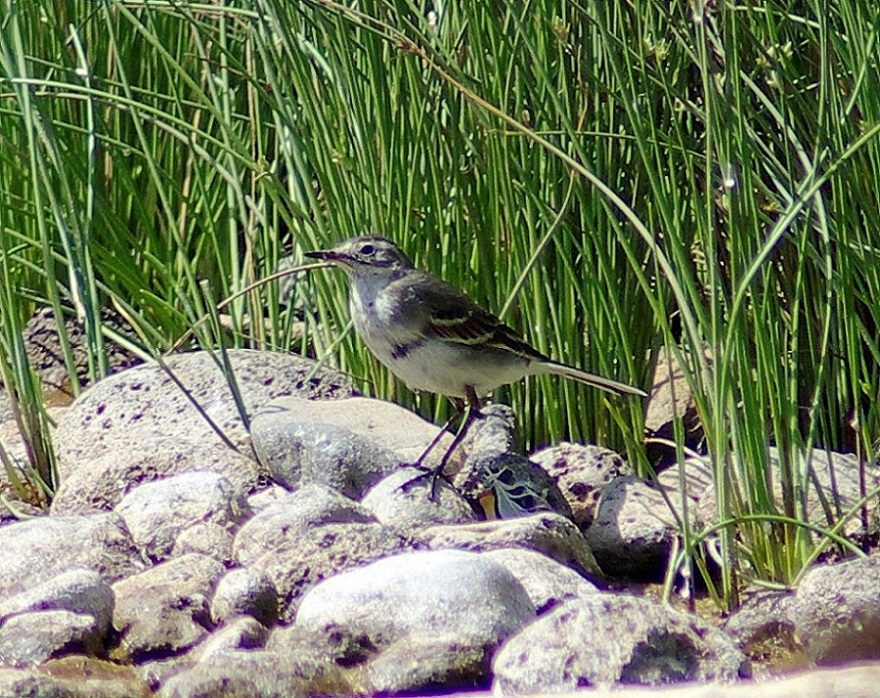Citroenkwikstaart
Motacilla citreola · (Western) Citrine Wagtail
 Citroenkwikstaart ·
Motacilla citreola
·
03-10-2014 · Rubén Barone
Citroenkwikstaart ·
Motacilla citreola
·
03-10-2014 · Rubén Barone
| Datum | 3 oktober 2014 |
|---|---|
| Locatie | Las Galletas, Tenerife (Canary Islands) |
| Fotograaf |
|
| Bekeken | 5570 × |
Juvenile bird. This species is a rare vagrant to the Canary Islands, but in recent years there is an increasing number of records for the archipelago. |
Discussie
George Sangster
·
1 december 2021 11:24, gewijzigd 1 december 2021 11:25
Ferlini, F & Olsen, KM 2021. Does the expansion of the species' breeding range also involve the establishment of new migratory routes and new wintering ranges? The case of the citrine wagtail Motacilla citreola (Pallas, 1776). Rivista italiana di Ornitologia in press.
Abstract: From the second half of the 20th century, some Asian or Eastern European species expanded their breeding range westward. These include red-flanked bluetail Tarsiger cyanurus, black-headed bunting Emberiza melanocephala, common rosefinch Carpodacus erythrinus, and citrine wagtail Motacilla citreola. All of these species are long-range migratory species that historically have their own wintering ranges concentrated in Southern Asia. Although migratory behavior is mainly controlled by genetic factors, there is evidence of a high degree of flexibility and adaptability. Therefore, in the event of specific environmental changes, the genetic basis for a rapid and diverse micro-evolutionary development that affects the future migration patterns of birds is already in place. Possible adaptations also include changes to migratory directions and the choice of new and closer winter quarters. It is therefore prudent to ask whether the long-range migratory species that have expanded their breeding range westward in Europe have also established new migration routes and wintering ranges. This research shows that over the last few decades, the wintering area of Motacilla citreola has expanded westwards, including significantly the Middle East and, to a lesser extent, Africa and Europe. Especially in the activation of the most western routes, a fundamental role was played by the phenomenon of post-fledging dispersal, manifested by young who, as also observed in other Asian passerines (e.g., Pallas's warbler Phylloscopus proregulus, yellow-browed warbler Phylloscopus inornatus, pine bunting Emberiza leucocephalos), in autumn moved in different directions than the typical migratory route of their species. The Middle East and the neighboring Horn of Africa are progressively increasing in relevance as an additional area for the wintering of the species as a whole. Similarly, if in Europe the expansion of the breeding range towards the west continues in the future, West Africa, reached through Gibraltar, could become important as additional wintering ranges. In analogy with what is being observed for the western yellow wagtail Motacilla flava, Europe itself is also becoming part of the wintering range of the species. In fact, there is an increase in cases of wintering not only in the south of the continent, but there is also a progression towards the north.
Maarten Wielstra
·
3 december 2021 04:11
https://waarneming.nl/observation/61237646/
Bij onderzoek naar Nederlandse roepjes van Citroenkwikstaart in het late najaar, ben ik 1x de oostelijke nominaatvorm citreola tegengekomen. Maar vermoedelijk ook een vogel uit de oostkant van de verspreiding van onze werae (zie bovenstaande link, calcarata zou het ook nog kunnen zijn, wordt aan gewerkt).
Laat maar komen, die overwinterende Citroenkwikken!
George Sangster
·
6 december 2021 10:10
Michał Korniluk, Paweł Białomyzy, Grzegorz Grygoruk, Tomasz Tumiel, Piotr Świętochowski & Marcin Wereszczuk 2021. Citrine Wagtail migration on the Indo-European flyway: a first geolocator track reveals alternative migration route and endurance flights to cross ecological barriers. Avian Research 12: 68
Most long-distance migrating passerines that breed in Europe spend their winters in Africa, with only a few species migrating eastward to spend the non-breeding period in South Asia. The use of the Indo-European flyway is rare and has been poorly studied so far. However, it is extremely interesting as within that system we are currently witnessing a recent range expansion of European breeding long distance migrants and thus the lengthening of migration routes. It may therefore conceal a unique migratory strategies and behaviour that can help us to understand the underlying factors and mechanisms determining the evolution of migration routes, strategies and breeding range extinction. Based on light-level geolocator we reveal a first track of the Citrine Wagtail (Motacilla citreola) migration, providing insight into the migration pattern, timing and behaviour of the species that recently has extended its migration routes. Unexpectedly, the studied individual did not retrace a recent range expansion that runs north and east from the Caspian Sea but followed a migration route running south from the Caspian sea, suggesting possible presence of an alternative species range expansion. The overall migration distance between the breeding site in Poland and the non-breeding site in Pakistan was about 10,420 km and included two endurance movement phases (920 and 2240 km) covering 30% of the whole journey length, with an average movement speed of 574 km/day. We explain this migration behaviour as an adaptation for crossing the ecological barriers imposed by arid environments.
Gebruikers van het forum gaan akkoord met de forumregels.
